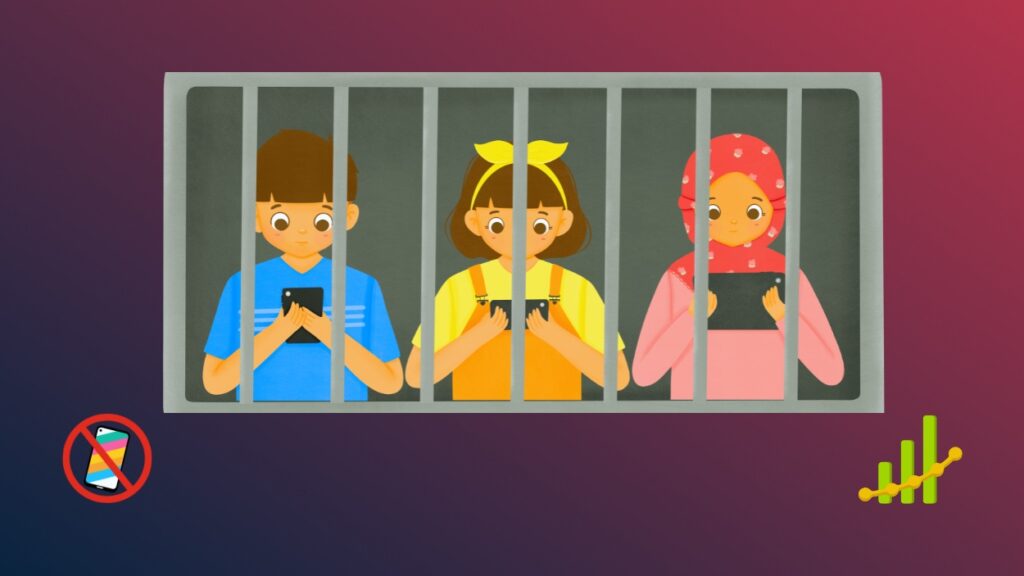Technology’s pull often feels impossible to resist. More than half of Americans report an almost daily reliance on smartphones, the internet, and social media, affecting everything from sleep to relationships. From health care settings where digital detox programs help patients reclaim balance, to corporate wellness initiatives that curb online burnout, technology addiction is now being treated as a real concern. Read on to explore pressing statistics that define today’s digital dependency.
Editor’s Choice
- 57% of Americans say they feel addicted to their phones.
- Americans check their phones an average of 144 times per day.
- 10% of the U.S. population (about 33.19 million people) is estimated to be addicted to social media.
- Globally, 210 million people suffer from social media and internet addiction.
- 36.7% of the global population is addicted to the internet, and 2.8% suffer severe addiction.
- As of 2025, more than 1.58 billion people globally may experience smartphone addiction, a 7.4% increase from the previous year.
- 5–10% of Americans meet clinical criteria for social media addiction.
Recent Developments
- A major U.S. study found nearly 50% of children show signs of mobile phone addiction, linked to mental health risks.
- A 2025 survey revealed families engage in over 500 tech-related arguments per year, roughly 96 hours of conflict.
- 67% of parents fear that screen time is replacing meaningful childhood moments.
- The “abstinence” movement is rising, with people opting for phones to escape digital overload.
- California’s Protecting Our Kids from Social Media Addiction Act (SB 976) aimed to restrict addictive feeds and notification timing, but faces legal challenges post-appeal.
Global Technology Addiction Trends
- 36.7% of the global population is internet-addicted, 33.9% moderately so, and 2.8% severely addicted.
- Approximately 6% of the global population struggles with smartphone dependence (nomophobia).
- Over 1.58 billion people worldwide may be experiencing some form of smartphone addiction in 2025, a 7.4% rise from last year.
- 210 million people globally suffer from social media and internet addiction.
- 4.69% of all global social media users are estimated to be addicted to platforms.
- Internet addiction prevalence varies, Asia up to 20%, Europe around 4.4%, while in North America, the U.S. adult rate was 0.3–0.7%.
- Addiction-crafting “dark patterns” are increasingly used by tech firms across the globe to keep users hooked.
Smartphone Addiction Statistics
- 57% of Americans admit to phone addiction.
- 56.9% of Americans acknowledge addiction to their phones.
- Americans average 144 phone calls per day, once every 10 minutes.
- 88.6% check their phones within 10 minutes of waking up.
- 44% feel anxious when they don’t have their phone.
- 71% sleep with or beside their smartphone.
- Nearly one in three kids shows signs of excessive smartphone use, and 66% report anxiety when separated from their phones.
- 15% of U.S. adults rely on smartphones only for internet access (no home broadband).
- Average daily phone use is expected to hit 4 hours 39 minutes per person.
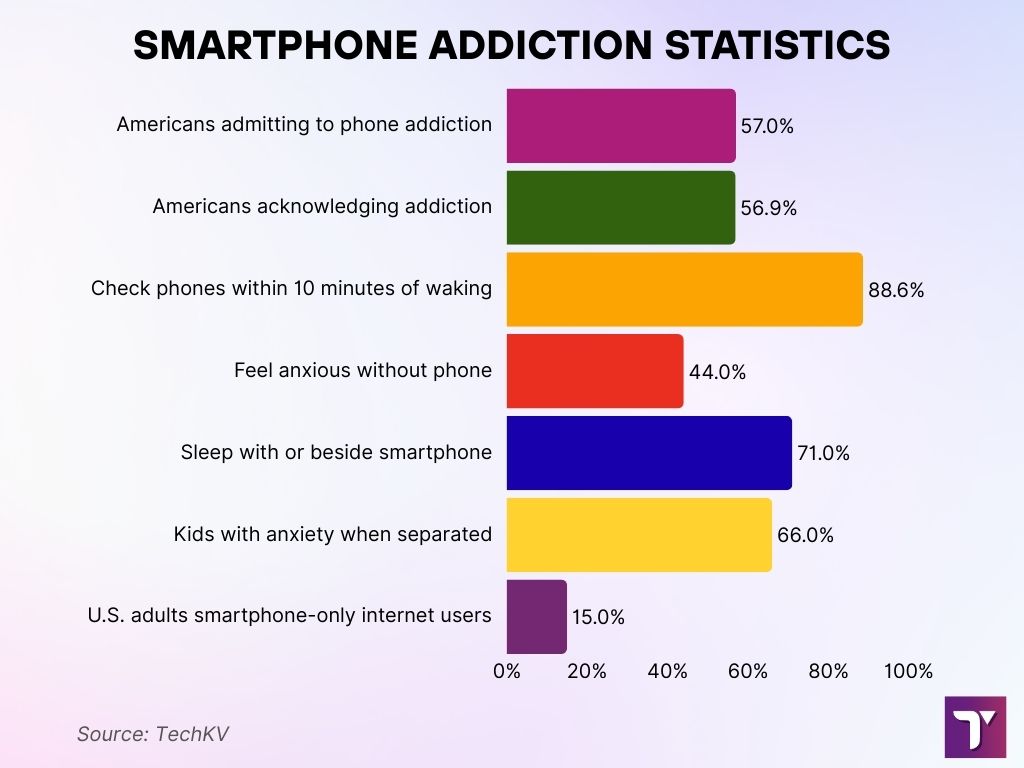
Internet Addiction Statistics
- 36.7% of the global population is internet-addicted, with 2.8% severely impacted.
- Prevalence varies significantly by region, Asia up to 20%, Europe 4.4%, and U.S. adults historically 0.3–0.7%.
- In many countries, adolescent rates are notably higher, 17–26.7% in Hong Kong, 16.3% in Spain.
- Global meta-analyses estimate around 6% prevalence overall.
Social Media Addiction Statistics
- 210 million people globally now struggle with social media and internet addiction.
- In the U.S., approximately 10%, or 33.19 million people, are addicted to social media.
- 30% of American adults say they feel addicted to social media.
- 82% of Gen Z adults in the U.S. believe they’re addicted to social media.
- 36% of teens admit to excessive social media use.
- Over 60% of U.S. college students report being addicted to social media.
- Platforms like Facebook, Instagram, and TikTok are commonly implicated, with average daily use: TikTok, 53.8 minutes; Instagram, 34 minutes; and Facebook, 31 minutes.
- 10–14% of American adults meet clinical criteria for social media addiction, about 33.19 million people.
- Psychologists estimate 5–10% of Americans meet the clinical standard today.
- 70% of U.S. adults use at least one social platform, with an average daily time of 2 hours 14 minutes.
- Nearly 50% of teens say they feel addicted to social media.
Video Game Addiction Statistics
- In the U.S., between 1.7% and 10% of the population meet the criteria for video game addiction.
- Globally, about 60 million people suffer from gaming disorders, representing 3–4% of gamers.
- An estimated 3.3% of gamers worldwide, or over 105 million people, are affected by video game addiction.
- At more detailed levels, prevalence can vary; one analysis suggests a general estimate of 3.05%, adjusted down to 1.96% under stricter criteria.
- A new study of 13,400 gamers on Steam found that 14.6% to 18.3% showed addiction-like behaviors, depending on the game type.
- In South Korea, as many as 10% of the population is estimated to have game addiction.
- UK estimates suggest 700,000 to 1 million gamers suffer from addiction out of millions of regular players.
- Excessive gaming behaviors remain underreported, but awareness is growing as diagnostic methods improve.
Average Weekly Time Spent Playing Video Games by Country
- China tops the list with an impressive 12 hours 23 minutes of gaming each week.
- Vietnam follows, with gamers spending around 10 hours and 9 minutes weekly.
- India averages 8 hours 36 minutes, while Indonesia is close behind at 8 hours 32 minutes.
- In the USA, players spend an average of 7 hours 42 minutes per week gaming.
- UK gamers clock in at about 7 hours 10 minutes weekly, nearly identical to Germany’s 7 hours 7 minutes.
- South Korea, despite its global reputation for gaming culture, records the lowest average at just 5 hours 52 minutes per week.
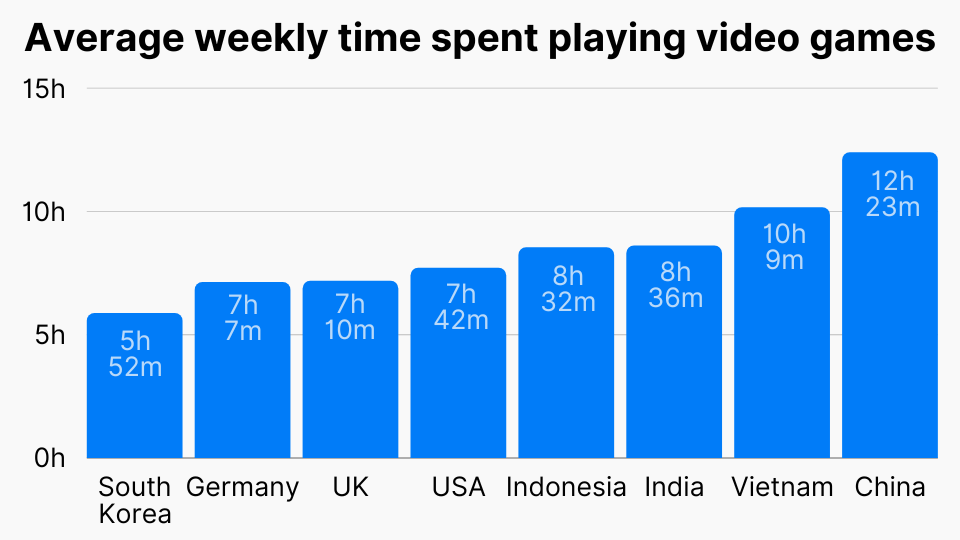
Technology Addiction by Age Group
- Nearly 50% of U.S. children (around age ten at the start) show signs of mobile phone addiction.
- Among those same children, over 40% exhibit addictive video game behaviors, and 30% show social media addiction patterns.
- The study also found children displaying compulsive screen use were 2–3 times more likely to experience suicidal thoughts or behaviors.
- In the U.S., teens around 13 years old report 37% experiencing aggression and 20% hallucinations linked to smartphone use, and these rates decrease slightly by age 17.
- The youngest age group showed more severe psychological effects, suggesting earlier phone exposure poses a higher risk.
- Parent surveys show tech disputes lead to over 500 arguments annually, about 96 hours of conflict per year.
- Around 67% of parents worry that screen time is eroding childhood experiences.
- Reported behavioral effects in children include irritability (27%), mood swings (24%), tantrums (22%), reduced attention (19%), anxiety (14%), and sleep issues (14%).
Technology Addiction in Children and Adolescents
- Approximately 50% of children show addictive mobile phone behaviors.
- Over 40% show addictive gaming behaviors, and 30% display growing social media addiction with age.
- High-risk children were 2–3 times more likely to report suicidal ideation.
- Teen smartphone use is linked to aggression (37%) and hallucinations (20%) among 13-year-olds.
- Severe psychological issues, anxiety, hopelessness, and withdrawal are common in teens with heavy device use.
- Families spend around 96 hours per year in tech-related conflicts, indicating struggles around enforcing limits.
- Behavioral issues in children include tantrums, mood issues, anxiety, and attention problems tied to screen explosion.
- Parents increasingly fear their children are losing childhood years to digital dependency.
Internet Addiction Risk by Age Group
- Teenagers aged 13–17 face the highest risk, with 73% vulnerable to internet addiction.
- Young adults 18–24 are close behind, at 71%, highlighting how early adulthood is a critical risk period.
- Adults aged 25–34 show a significant risk as well, with 59% affected.
- The risk drops to 54% for those aged 35–44, showing a gradual decline with age.
- Middle-aged groups see lower rates: 40% for ages 45–54 and 39% for 55–64.
- Interestingly, those 65 and older experience a slight increase, with 44% at risk, higher than many middle-aged groups.
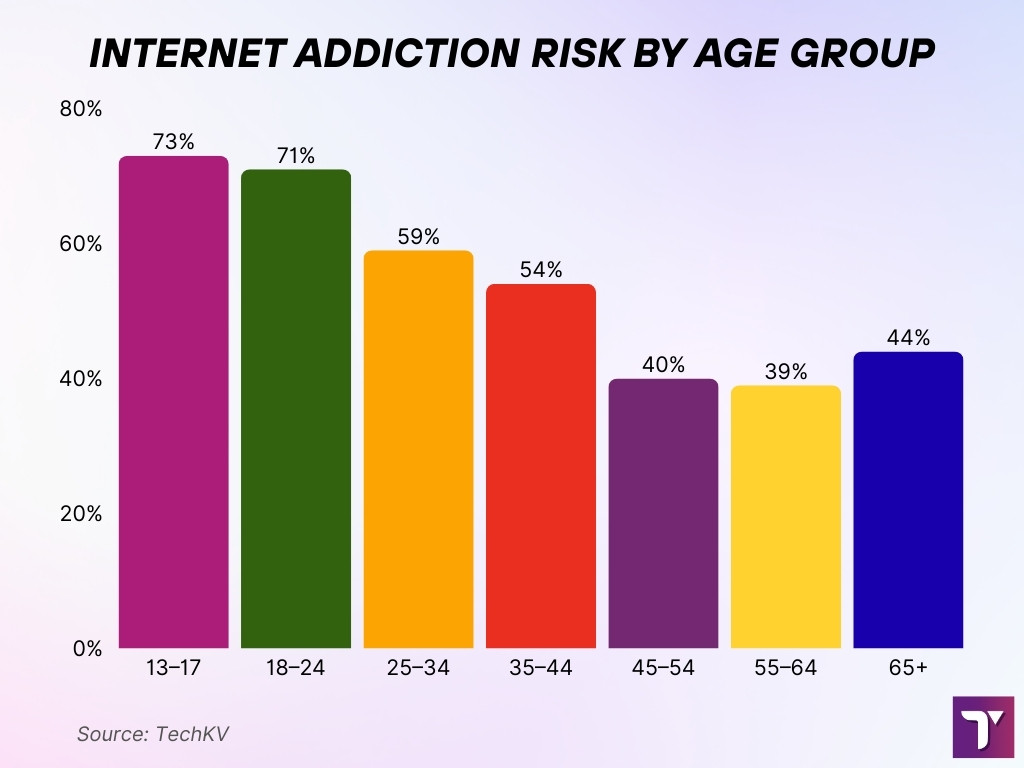
Technology Addiction in Adults
- In 2025, about 1.08 billion people worldwide are estimated to be affected by some form of technology addiction, based on patterns of compulsive digital use.
- In the United States, nearly 19% of adults exhibit moderate to severe digital dependency.
- Globally, around 36.7% of people show signs of internet addiction, including 33.9% with moderate and 2.8% with severe symptoms.
- A study of Korean adults in 2023 found a 12.0% prevalence of digital addiction, defined as impaired daily functioning due to excessive internet, gaming, or smartphone use.
- Among smartphone users, approximately 6.3% globally show clinical levels of addiction, although this rate can range as high as 67.8% in certain groups.
- Medical students are particularly vulnerable, with technology addiction rates ranging from 15.6% to 81.1%, depending on the region and assessment methods.
- According to data from the University of Michigan, about 210 million people worldwide suffer from addiction to social media and the internet.
- In the U.S., 10% of adults, or roughly 33 million people, are estimated to be addicted to social media.
- Among Americans aged 18 to 22, 40% report social media addiction, highlighting significant vulnerability in young adults.
- Global estimates suggest that 3.8 billion people, or over 48% of the world population, are considered addicted to their phones.
Mental Health Effects of Technology Addiction
- 210 million people globally suffer from social media and internet addiction.
- In the U.S., 10% of adults, or about 33.2 million people, are estimated to be addicted to social media.
- Among Gen Z adults, a striking 82% acknowledge their dependency on platforms like Instagram and TikTok.
- 50% of teens feel addicted to their mobile devices, and 27% of parents feel the same.
- Adults who self-identify as smartphone addicted rose from 31% in 2023 to 38% in 2025.
- Individuals with poor mental health report feeling reliant on technology at a rate of 79%, compared to 62% of those with better mental health.
- Risk of depression increases nearly 2.5× in those with moderate to severe internet addiction.
- Heavy social media users, particularly young adults 19–32, show 2-3× higher odds of perceived social isolation.
- Excessive screen time (≥ 4 hours/day) among younger populations correlates with a higher risk for anxiety, depression, and behavioral issues.
Behavioral Patterns Associated with Technology Addiction
- Smartphone addiction affects around 6.3% globally, but can range up to 67.8% in certain groups like students.
- Medical students show especially high addiction rates, 15.6% to 81.1%, depending on the study.
- Heavy social media users are 2–3 times more likely to feel socially isolated, especially among 19–32-year-olds.
- Technostress symptoms include compulsive connectivity, multitasking, anxiety, and disrupted thought processes.
- Younger adults (18–24) face a 71% risk of internet addiction, and teens (13–17) are at a 73% risk.
- Difficulty disconnecting correlates with age; 44% of 15–19-year-olds, 41% of 20–29, and 38% of 30–39 find it hard to take tech breaks.
- 33% of tech users struggle to break from their devices, about 1 in 3 across multiple countries.
- Among U.S. adults, 38% of people in the U.S. and EU report heavy dependence on technology.
- Those with poor mental health report 79% reliance on technology, compared to 62% among those reporting better mental health.
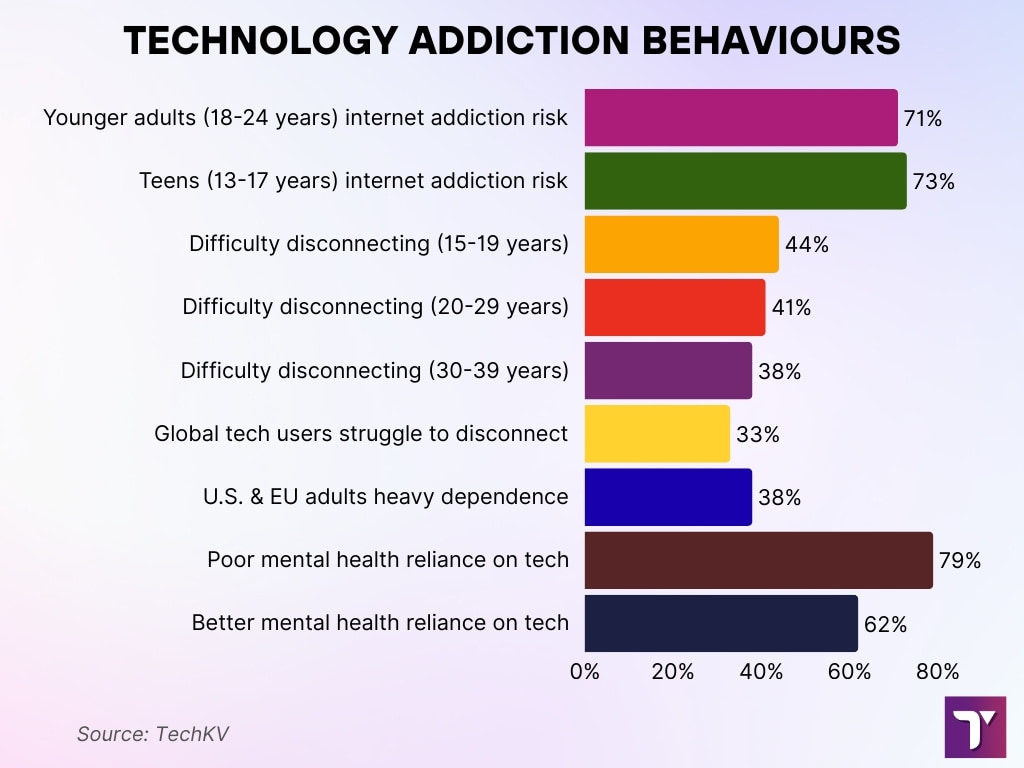
Physical Health Effects of Technology Addiction
- In 2025, 38% of U.S. adults say they’re “addicted” to their smartphones, up from 31% in 2023.
- Smartphone owners tap, swipe, or click their devices 2,617 times per day on average.
- About 87% of users check their phones within an hour of going to sleep or immediately upon waking.
- 69% do so within 5 minutes of waking.
- Excessive screen time leads to headaches, eye strain, poor sleep, anxiety, and low self-esteem, according to health experts.
- Physical outcomes of technology overuse include “tech-neck,” chronic pain, eye strain, and even structural brain changes like reduced gray matter or thinner cerebral cortex.
- Wearable devices, used by 32% of Americans, especially 69% of 25–34-year-olds, can cause “tracking anxiety” and unnecessary medical consultations in about 20% of users.
- Blue light exposure from screens suppresses melatonin, disrupting REM cycles and memory consolidation.
- Physical strain and posture issues from screen use extend beyond discomfort; detox practices show reduced eye strain and neck pain when implemented.
Technology Addiction and Family Dynamics
- Parents report over 500 tech-related arguments per year, totaling about 96 hours of conflict annually over screen use.
- About 67% of parents fear that screen time is stealing precious childhood moments, and 41% believe it’s taking away entire childhoods.
- Excessive parental screen use (a behavior known as phubbing) appears in 51.5% of parent-teen interactions, which worsens mobile addiction and increases depression and aggression in adolescents.
- Digital dependence often amplifies tensions in families that use reactive rather than collaborative approaches to screen-time rules.
- Studies show enlightened parenting styles, rooted in emotional warmth and high socioeconomic support, can buffer children from digital addiction.
- Collaborative tools like family co-monitoring apps aim to bridge the generational tech gap, but uptake remains modest.
Impacts on Academic Performance
- Students spend 6–8 hours daily on non-academic screen time, which eats into their study time and weakens focus.
- Students using social media during study sessions score 20% lower on exams.
- A meta-analysis found a weak but significant negative correlation between smartphone/social media use and academic outcomes.
- At Walter Sisulu University, 84.5% of students spend over four hours daily on social media, and 39.4% say it negatively affects their assignments.
- Nearly 68% of students acknowledge that their phone use harms their academic performance.
- 40% of students check their phones every 5–10 minutes while studying, dramatically reducing study effectiveness.
- Among medical undergraduates, 40% show signs of smartphone addiction, with most using phones for entertainment, not academics.
- Secondary and university students face 5½ hours of daily mobile use on average, leading to shorter attention spans and poorer performance.
- Teachers report that 67% of students are distracted by mobile devices during class, impacting engagement and retention.
- 90% of teachers back removing phones during class, to improve focus
Causes and Risk Factors of Technology Addiction
- A recent meta-analysis of 35,623 adults found a moderate positive correlation between loneliness and internet addiction (r = 0.291), indicating that higher loneliness is associated with a greater likelihood of addictive digital behavior.
- In the same analysis, 92.2% of observed variance in that correlation reflected real differences across studies, underlining the robustness of the loneliness–addiction link.
- A 2025 study of 687 adults in their 20s showed that impulse-control difficulties and emotional dysregulation were central to smartphone overdependence, highlighting impulsivity as a core risk factor.
- Global smartphone addiction rates hover around 6.3%, but climb to as high as 67.8% in specific groups like medical students, indicating strong subgroup variance.
- Female smartphone users consistently report higher addiction levels than males across multiple countries, underscoring gender-based risk differences.
- Medical students display especially high addiction prevalence, ranging from 15.6% to 81.1%, pointing to intense academic and stress-related vulnerabilities in that group.
- In Saudi young adults, each one-point rise on a loneliness scale increases the risk of social media addiction by 12%, while individuals with very high loneliness face 7.8 times greater odds of addiction compared to those with low loneliness.
- Low self-esteem also plays a role: each point increase in self-esteem score lowers the odds of social media addiction by nearly 10%.
- Physical inactivity doubles the risk (OR = 1.9) of developing social media addiction, highlighting lifestyle and behavioral correlates.
- Platform design features, like infinite scroll, variable rewards, and push notifications, contribute to compulsive engagement, with 25% of users self-reporting multiple problematic smartphone behaviors due to persuasive designs.
Treatment and Recovery Rates
- Digital detox programs report a 72% success rate in reducing technology addiction symptoms.
- App blockers reduce compulsive checking behaviors by 61%.
- Behavioral therapy enhances self-regulation in 83% of individuals who complete interventions.
- In an experimental trial of a digital CBT-based intervention, the abstinence rate (weeks 9–12) was 73.3% versus 30.8% in the control group.
- A meta-analysis evaluating psychotherapy (primarily CBT) across 10 studies with 1,036 participants showed a large effect size (Hedges’ g = -1.34), indicating a strong reduction in symptoms.
- CBT-IA (Internet Addiction specific CBT) yielded over 95% symptom management at the end of 12 weeks, with 78% of clients sustaining recovery six months later.
- General CBT shows a 42% response rate, compared to 19% in control groups; 36% of CBT patients achieve remission versus 15% of controls.
- Long-term remission rates for CBT are 61.4% post-treatment, 75% at six months, and 63.6% at long-term follow-up.
- A systematic review of interventions for Internet Gaming Disorder (IGD) found that CBT significantly reduced IGD severity, as well as anxiety and depression symptoms.
- Among those affected by Internet Gaming Disorder, up to 50% may recover naturally without structured intervention.
Conclusion
Technology addiction is reshaping our health, homes, schools, and workplaces. From physical strain like sleep loss and posture issues to strained family bonds, every aspect of daily life bears the digital imprint. Academic struggles and productivity dips further underline the pervasive reach of tech dependence. Yet, a hopeful path forward exists, combining physical activity, supportive therapy, parental engagement, and mindful digital habits shows real recovery potential. Understanding these patterns and acting on them can help us reclaim balance in a world that pulls us online.
